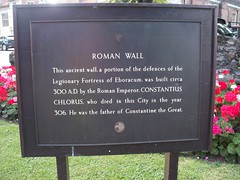Constantius Chlorus


Constantius Chlorus
(250-306)
Family tree
Commemorated on 1 plaque
Roman Wall. This ancient wall, a portion of the defences of the Legionary Fortress of Eboracum, was built circa 300 A. D. by the Roman Emperor, Constantius Chlorus, who died in this City in the year 306. He was the father of Constantine the Great.
St. Leonard's Place, York, United Kingdom where they built (299)

